VOLVO S60 2009 Owner´s Manual
Manufacturer: VOLVO, Model Year: 2009, Model line: S60, Model: VOLVO S60 2009Pages: 254, PDF Size: 6.17 MB
Page 31 of 254
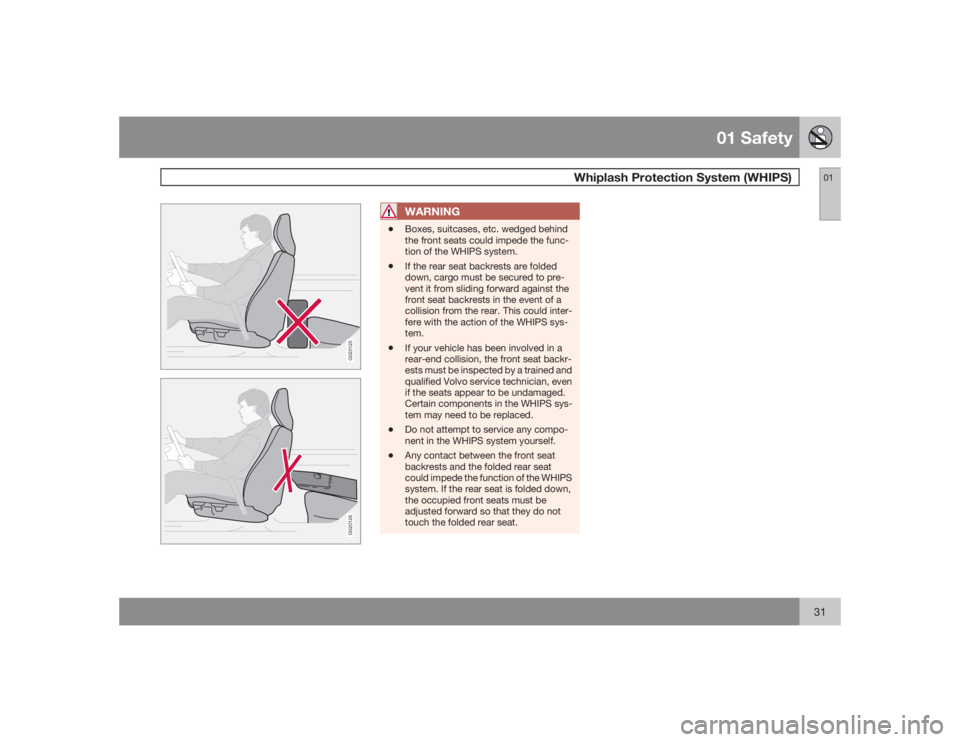
01 Safety
Whiplash Protection System (WHIPS)
0131
G020125G020126
WARNING
•
Boxes, suitcases, etc. wedged behind
the front seats could impede the func-
tion of the WHIPS system.
•
If the rear seat backrests are folded
down, cargo must be secured to pre-
vent it from sliding forward against the
front seat backrests in the event of a
collision from the rear. This could inter-
fere with the action of the WHIPS sys-
tem.
•
If your vehicle has been involved in a
rear-end collision, the front seat backr-
ests must be inspected by a trained and
qualified Volvo service technician, even
if the seats appear to be undamaged.
Certain components in the WHIPS sys-
tem may need to be replaced.
•
Do not attempt to service any compo-
nent in the WHIPS system yourself.
•
Any contact between the front seat
backrests and the folded rear seat
could impede the function of the WHIPS
system. If the rear seat is folded down,
the occupied front seats must be
adjusted forward so that they do not
touch the folded rear seat.
Page 32 of 254

01 SafetyChild safety
0132
Children should be seated safelyVolvo recommends the proper use of restraint
systems for all occupants including children.
Remember that, regardless of age and size, a
child should always be properly restrained in a
vehicle.
Your vehicle is also equipped with ISOFIX/
LATCH attachments, which make it more con-
venient to install child seats.
Some restraint systems for children are
designed to be secured in the vehicle by lap
belts or the lap portion of a lap-shoulder belt.
Such child restraint systems can help protect
children in vehicles in the event of an accident
only if they are used properly. However, chil-
dren could be endangered in a crash if the child
restraints are not properly secured in the vehi-
cle. Failure to follow the installation instructions
for your child restraint can result in your child
striking the vehicle's interior in a sudden stop.
Holding a child in your arms is NOT a suitable
substitute for a child restraint system. In an
accident, a child held in a person's arms can
be crushed between the vehicle's interior and
an unrestrained person. The child could also be
injured by striking the interior, or by being ejec-
ted from the vehicle during a sudden maneuver
or impact. The same can also happen if the
infant or child rides unrestrained on the seat.
Other occupants should also be properlyrestrained to help reduce the chance of injuring
or increasing the injury of a child.
All states and provinces have legislation gov-
erning how and where children should be car-
ried in a vehicle. Find out the regulations
existing in your state or province. Recent acci-
dent statistics have shown that children are
safer in rear seating positions than front seating
positions when properly restrained. A child
restraint system can help protect a child in a
vehicle. Here's what to look for when selecting
a child restraint system:
•
It should have a label certifying that it
meets applicable Federal Motor Vehicle
Safety Standards (FMVSS 213) – or in Can-
ada, CMVSS 213.
•
Make sure the child restraint system is
approved for the child's height, weight and
development – the label required by the
standard or regulation, or instructions for
infant restraints, typically provide this infor-
mation.
•
In using any child restraint system, we urge
you to carefully look over the instructions
that are provided with the restraint. Be sure
you understand them and can use the
device properly and safely in this vehicle.
A misused child restraint system can result
in increased injuries for both the infant or
child and other occupants in the vehicle.When a child has outgrown the child safety
seat, you should use the rear seat with the
standard seat belt fastened. The best way to
help protect the child here is to place the child
on a cushion so that the seat belt is properly
located on the hips, see page 34. Legislation
in your state or province may mandate the use
of a child seat or cushion in combination with
the seat belt, depending on the child's age and/
or size. Please check local regulations.
A specially designed and tested booster cush-
ion (not available in Canada) can be obtained
from your Volvo retailer for children weighing
33 – 80 lb. (15 – 36 kg) and 38 – 54 inches
(97 – 137 cm) in height.
Page 33 of 254
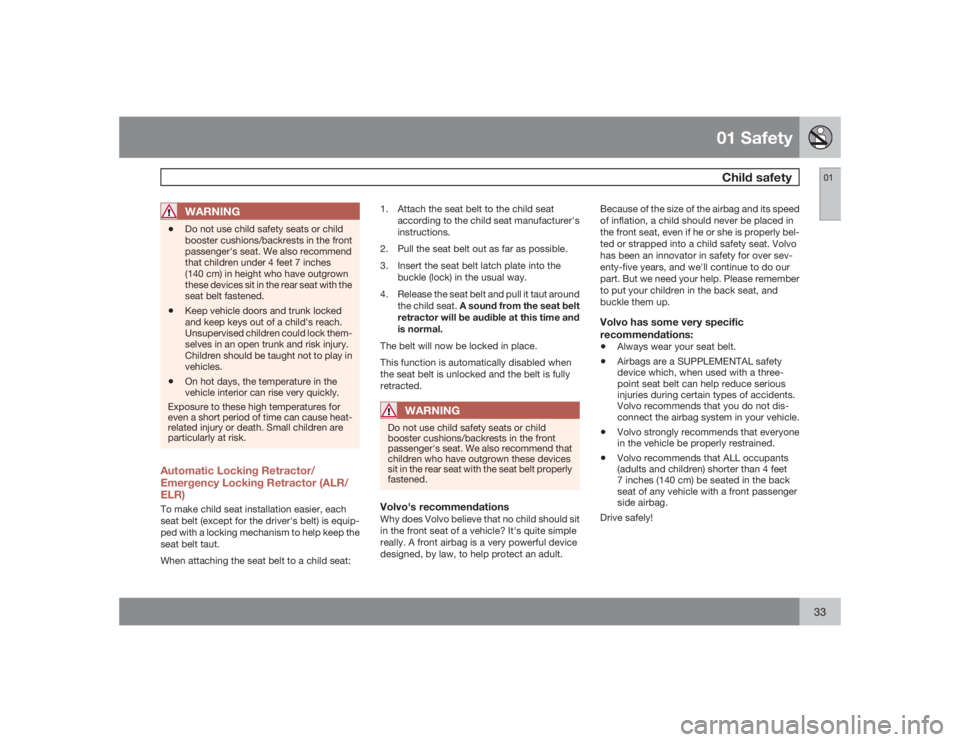
01 SafetyChild safety
0133
WARNING
•
Do not use child safety seats or child
booster cushions/backrests in the front
passenger's seat. We also recommend
that children under 4 feet 7 inches
(140 cm) in height who have outgrown
these devices sit in the rear seat with the
seat belt fastened.
•
Keep vehicle doors and trunk locked
and keep keys out of a child's reach.
Unsupervised children could lock them-
selves in an open trunk and risk injury.
Children should be taught not to play in
vehicles.
•
On hot days, the temperature in the
vehicle interior can rise very quickly.
Exposure to these high temperatures for
even a short period of time can cause heat-
related injury or death. Small children are
particularly at risk.
Automatic Locking Retractor/
Emergency Locking Retractor (ALR/
ELR)To make child seat installation easier, each
seat belt (except for the driver's belt) is equip-
ped with a locking mechanism to help keep the
seat belt taut.
When attaching the seat belt to a child seat:1. Attach the seat belt to the child seat
according to the child seat manufacturer's
instructions.
2. Pull the seat belt out as far as possible.
3. Insert the seat belt latch plate into the
buckle (lock) in the usual way.
4. Release the seat belt and pull it taut around
the child seat. A sound from the seat belt
retractor will be audible at this time and
is normal.
The belt will now be locked in place.
This function is automatically disabled when
the seat belt is unlocked and the belt is fully
retracted.
WARNING
Do not use child safety seats or child
booster cushions/backrests in the front
passenger's seat. We also recommend that
children who have outgrown these devices
sit in the rear seat with the seat belt properly
fastened.Volvo's recommendationsWhy does Volvo believe that no child should sit
in the front seat of a vehicle? It's quite simple
really. A front airbag is a very powerful device
designed, by law, to help protect an adult.Because of the size of the airbag and its speed
of inflation, a child should never be placed in
the front seat, even if he or she is properly bel-
ted or strapped into a child safety seat. Volvo
has been an innovator in safety for over sev-
enty-five years, and we'll continue to do our
part. But we need your help. Please remember
to put your children in the back seat, and
buckle them up.
Volvo has some very specific
recommendations:•
Always wear your seat belt.
•
Airbags are a SUPPLEMENTAL safety
device which, when used with a three-
point seat belt can help reduce serious
injuries during certain types of accidents.
Volvo recommends that you do not dis-
connect the airbag system in your vehicle.
•
Volvo strongly recommends that everyone
in the vehicle be properly restrained.
•
Volvo recommends that ALL occupants
(adults and children) shorter than 4 feet
7 inches (140 cm) be seated in the back
seat of any vehicle with a front passenger
side airbag.
Drive safely!
Page 34 of 254
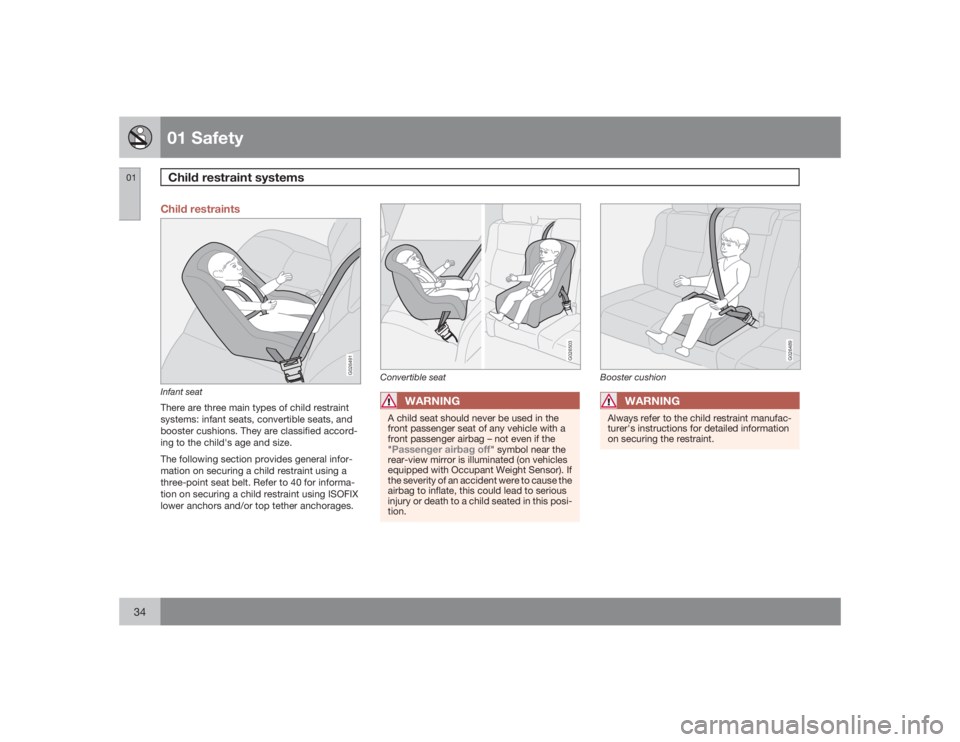
01 SafetyChild restraint systems
0134
Child restraints
G026491
Infant seatThere are three main types of child restraint
systems: infant seats, convertible seats, and
booster cushions. They are classified accord-
ing to the child's age and size.
The following section provides general infor-
mation on securing a child restraint using a
three-point seat belt. Refer to 40 for informa-
tion on securing a child restraint using ISOFIX
lower anchors and/or top tether anchorages.
G026503
Convertible seat
WARNING
A child seat should never be used in the
front passenger seat of any vehicle with a
front passenger airbag – not even if the
"Passenger airbag off
" symbol near the
rear-view mirror is illuminated (on vehicles
equipped with Occupant Weight Sensor). If
the severity of an accident were to cause the
airbag to inflate, this could lead to serious
injury or death to a child seated in this posi-
tion.
G026489
Booster cushion
WARNING
Always refer to the child restraint manufac-
turer's instructions for detailed information
on securing the restraint.
Page 35 of 254
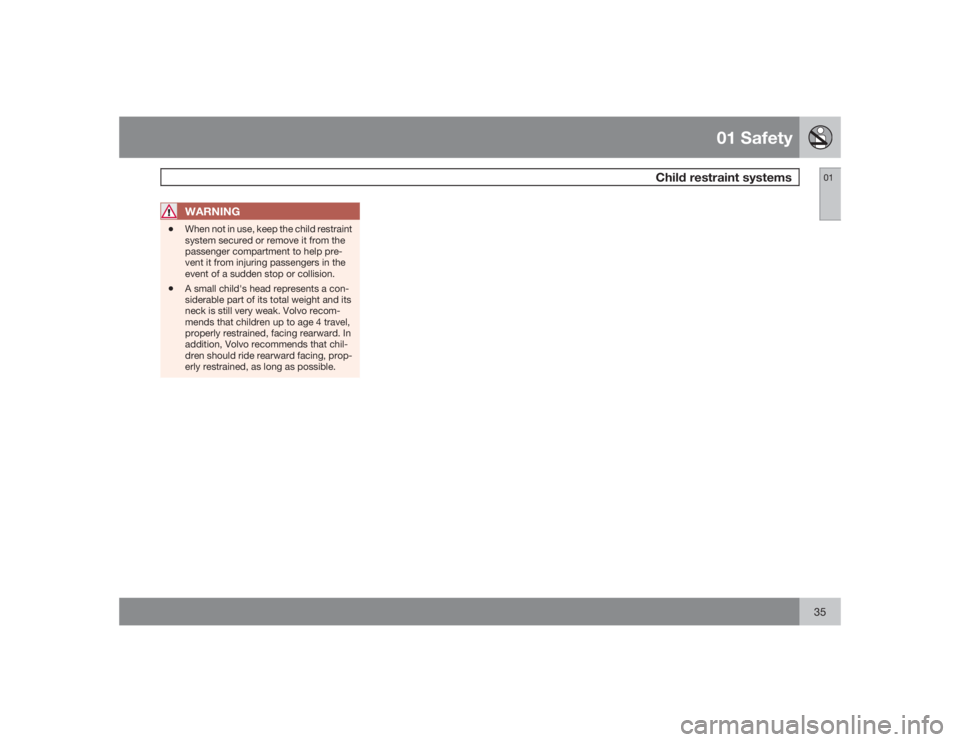
01 Safety
Child restraint systems
0135
WARNING
•
When not in use, keep the child restraint
system secured or remove it from the
passenger compartment to help pre-
vent it from injuring passengers in the
event of a sudden stop or collision.
•
A small child's head represents a con-
siderable part of its total weight and its
neck is still very weak. Volvo recom-
mends that children up to age 4 travel,
properly restrained, facing rearward. In
addition, Volvo recommends that chil-
dren should ride rearward facing, prop-
erly restrained, as long as possible.
Page 36 of 254

01 SafetyInfant seats
0136
Securing an infant seat with a seat belt
G026417
Do not place the infant seat in the front passeng-
er's seat
NOTE
Refer to 41 for information on securing a
child restraint using ISOFIX lower anchors
and/or top tether anchorages.1. Place the infant seat in the rear seat of the
vehicle.
2. Attach the seat belt to the infant seat
according to the manufacturer's instruc-
tions.
G026493
Positioning the seat belt through the infant seat
WARNING
•An infant seat must be in the rear-facing
position only.•The infant seat should not be positioned
behind the driver's seat unless there is
adequate space for safe installation.
WARNING
A child seat should never be used in the
front passenger seat of any vehicle with a
front passenger airbag – not even if thePassenger airbag off
symbol near the
rear-view mirror is illuminated (on vehicles
equipped with Occupant Weight Sensor). If
the severity of an accident were to cause the
airbag to inflate, this could lead to serious
injury or death to a child seated in this posi-
tion.
3. Fasten the seat belt by inserting the latch
plate into the buckle (lock) until a distinct
click is audible.
Page 37 of 254
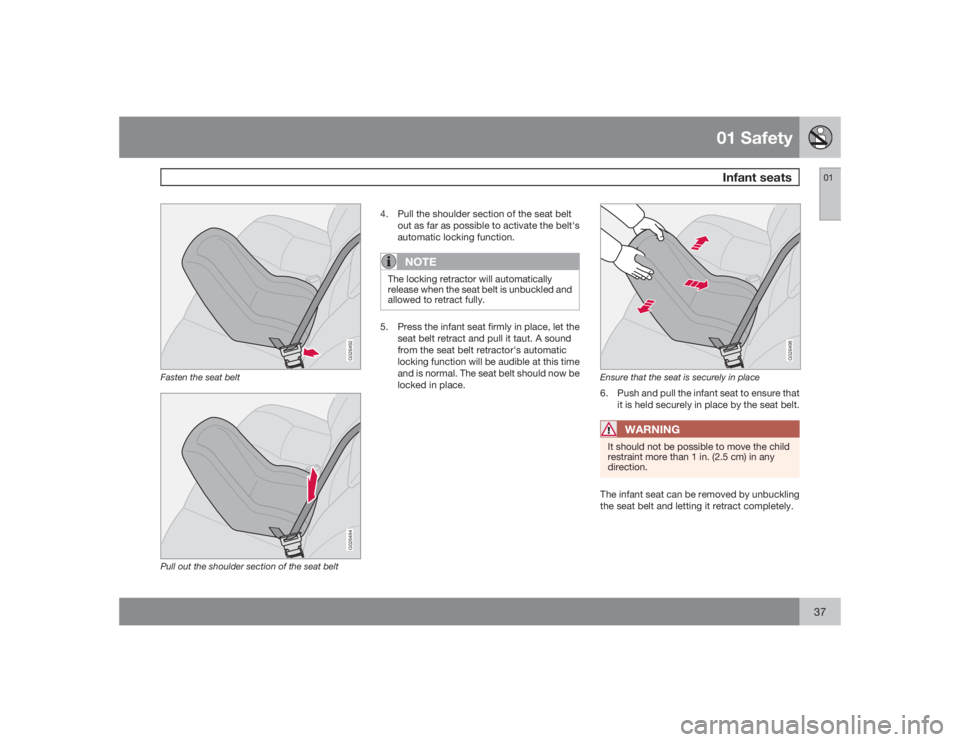
01 SafetyInfant seats
0137
G026492
Fasten the seat belt
G026494
Pull out the shoulder section of the seat belt
4. Pull the shoulder section of the seat belt
out as far as possible to activate the belt's
automatic locking function.
NOTE
The locking retractor will automatically
release when the seat belt is unbuckled and
allowed to retract fully.5. Press the infant seat firmly in place, let the
seat belt retract and pull it taut. A sound
from the seat belt retractor's automatic
locking function will be audible at this time
and is normal. The seat belt should now be
locked in place.
G026498
Ensure that the seat is securely in place6. Push and pull the infant seat to ensure that
it is held securely in place by the seat belt.
WARNING
It should not be possible to move the child
restraint more than 1 in. (2.5 cm) in any
direction.The infant seat can be removed by unbuckling
the seat belt and letting it retract completely.
Page 38 of 254
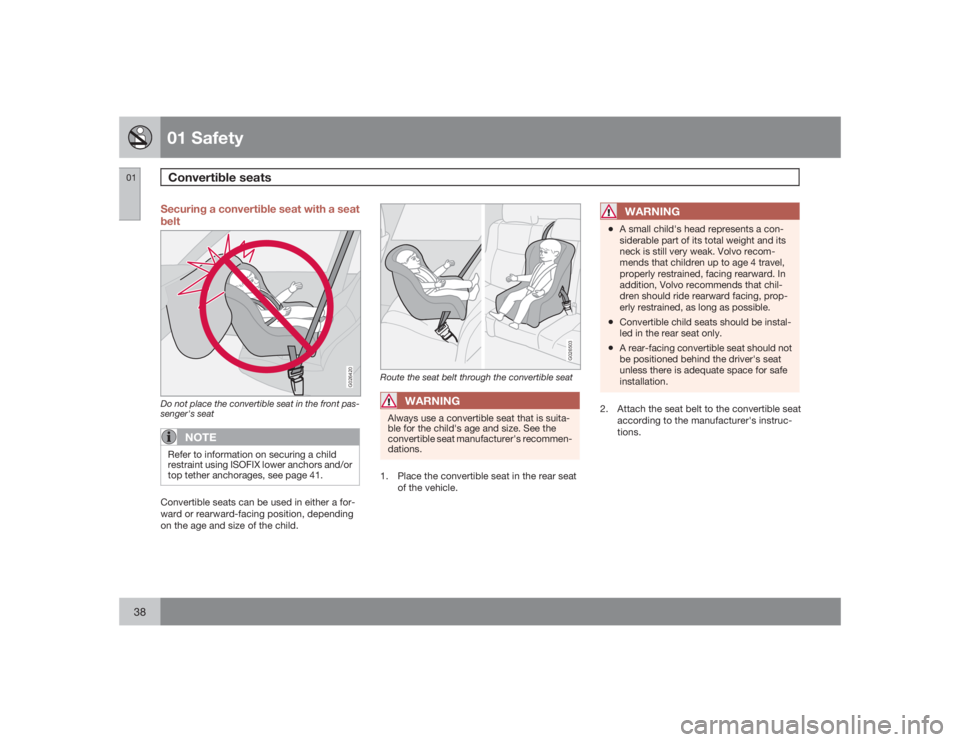
01 SafetyConvertible seats
0138
Securing a convertible seat with a seat
belt
G026420
Do not place the convertible seat in the front pas-
senger's seat
NOTE
Refer to information on securing a child
restraint using ISOFIX lower anchors and/or
top tether anchorages, see page 41.Convertible seats can be used in either a for-
ward or rearward-facing position, depending
on the age and size of the child.
G026503
Route the seat belt through the convertible seat
WARNING
Always use a convertible seat that is suita-
ble for the child's age and size. See the
convertible seat manufacturer's recommen-
dations.1. Place the convertible seat in the rear seat
of the vehicle.
WARNING
•A small child's head represents a con-
siderable part of its total weight and its
neck is still very weak. Volvo recom-
mends that children up to age 4 travel,
properly restrained, facing rearward. In
addition, Volvo recommends that chil-
dren should ride rearward facing, prop-
erly restrained, as long as possible.•Convertible child seats should be instal-
led in the rear seat only.•A rear-facing convertible seat should not
be positioned behind the driver's seat
unless there is adequate space for safe
installation.
2. Attach the seat belt to the convertible seat
according to the manufacturer's instruc-
tions.
Page 39 of 254

01 Safety
Convertible seats
0139
G026500
Fasten the seat belt3. Fasten the seat belt by inserting the latch
plate into the buckle (lock) until a distinct
click is audible.
4. Pull the shoulder section of the seat belt
out as far as possible to activate the belt's
automatic locking function.
NOTE
The locking retractor will automatically
release when the seat belt is unbuckled and
allowed to retract fully.5. Press the convertible seat firmly in place,
let the seat belt retract and pull it taut. Asound from the seat belt retractor's auto-
matic locking function will be audible at this
time and is normal. The seat belt should
now be locked in place.
G026501
Pull out the shoulder section of the seat belt6. Push and pull the convertible seat to
ensure that it is held securely in place by
the seat belt.
WARNING
It should not be possible to move the child
restraint more than 1 in. (2.5 cm) in any
direction.
The convertible seat can be removed by
unbuckling the seat belt and letting it retract
completely.
G026502
Ensure that the seat is securely in place
WARNING
A child seat should never be used in the
front passenger seat of any vehicle with a
front passenger airbag – not even if the
"Passenger airbag off
" symbol near the
rear-view mirror is illuminated (on vehicles
equipped with Occupant Weight Sensor). If
the severity of an accident were to cause the
airbag to inflate, this could lead to serious
injury or death to a child seated in this posi-
tion.
Page 40 of 254
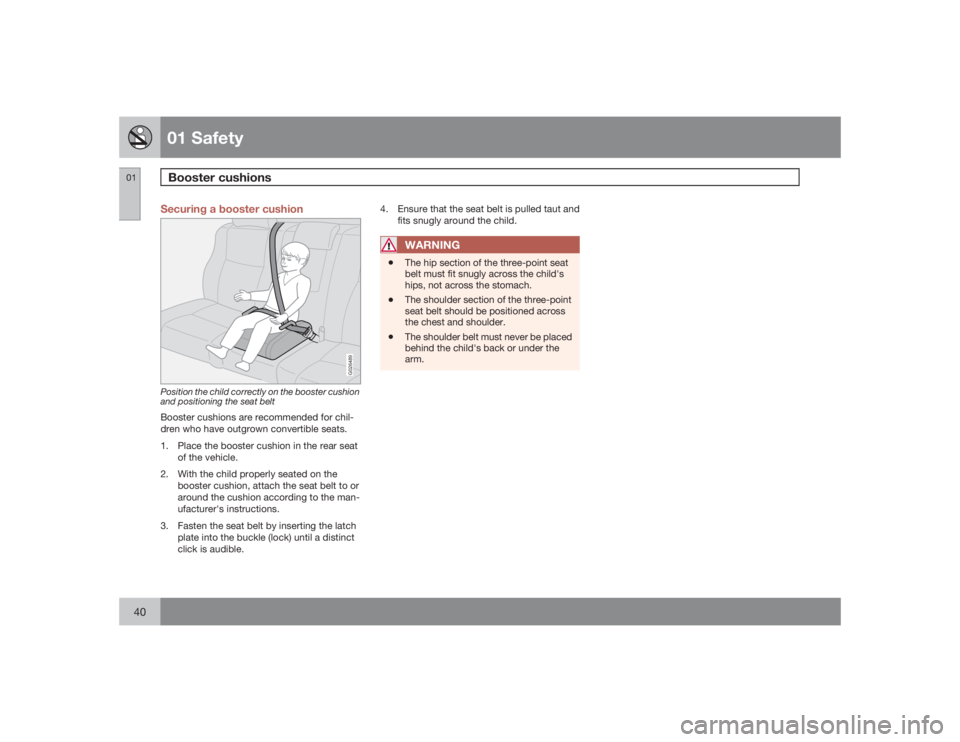
01 SafetyBooster cushions
0140
Securing a booster cushion
G026489
Position the child correctly on the booster cushion
and positioning the seat beltBooster cushions are recommended for chil-
dren who have outgrown convertible seats.
1. Place the booster cushion in the rear seat
of the vehicle.
2. With the child properly seated on the
booster cushion, attach the seat belt to or
around the cushion according to the man-
ufacturer's instructions.
3. Fasten the seat belt by inserting the latch
plate into the buckle (lock) until a distinct
click is audible.4. Ensure that the seat belt is pulled taut and
fits snugly around the child.
WARNING
•
The hip section of the three-point seat
belt must fit snugly across the child's
hips, not across the stomach.
•
The shoulder section of the three-point
seat belt should be positioned across
the chest and shoulder.
•
The shoulder belt must never be placed
behind the child's back or under the
arm.